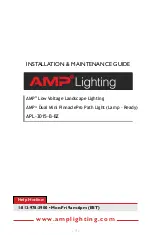
USE ONLY GENUINE REPLACEMENT PARTS
Page 19 of 21
Aq
Rev. B
Setting the redox level (redox kit option)
The redox level tells you the oxidation potential, i.e. the disinfectant capacity of the water.
Setting the redox set point is the last step in setting the Aq.
To find the optimum redox level for your pool, follow the steps below:
1) Start up the pool filtration system (the salt in the pool must be evenly dissolved).
2) Add chlorine to the swimming pool until it reaches 1 to 1.5 ppm. This level is achieved with (approximately 1 to 1.5 g/m
3
of water).
The pH level must vary between 7.2 and 7.5.
3) After 30 min. Check whether the level of free chlorine in the pool (DPD1 test kit manual) is between 0.8 and 1.0 ppm.
4) Look at the redox value on the screen and enter it as the redox set point.
5) The next day, check the free chlorine levels (DPD1 test kit manual) and the redox level. Increase / reduce the setting, if
required.
Remember to check all your water parameters at regular intervals (2-3 months) (see table) and adjust the redox set point
according to the steps listed above.
SERVICING
During the first 10-15 days, your system will require more attention:
- Check that the pH remains at the ideal level (7.2 to 7.4).
- If the pH is exceptionally unstable and uses a lot of acid, check the alkalinity (see table).
If the balance is highly unstable, contact your pool installer/builder.
REMEMBER
that the system needs a certain amount of time to adapt to your pool and will require additional chemicals
during the first 3-5 days.
The pool must be regularly maintained and the skimmer baskets emptied whenever necessary.
Also check that your filter is not clogged.
ADD WATER
: It is preferable to add water via the skimmers so that it passes through the cell before entering the pool.
Remember to check the percentage of salt after adding water.
DOSING PUMPS
: Regularly check the acid level to ensure that the pump does not run dry. The dosing pump must be
checked and serviced at regular intervals.
Servicing the probes
The probes must be clean and free from oil, chemical deposits and contamination to function properly. As they are in
continuous contact with the water in the pool, the probes may need to be cleaned weekly or monthly, depending on the
number of bathers and other specific pool characteristics. A slow response, more frequent pH calibration and inconsistent
readings indicate that the probes need to be cleaned.
To clean the probes, turn off the power to the Aq.
Unplug the probe connectors from the communication box, unscrew the probes and carefully remove them from the
chamber. Clean the reference bulb (white ring at the bottom of the body of the probe) with a soft toothbrush and regular
toothpaste.
A household washing-up liquid detergent may also be used to remove any oil.
Rinse with fresh water, replace the Teflon tape on the threads, and reinstall the probes.
If the probes continue to give inconsistent readings or require excessive calibration after they have been cleaned, they
should be replaced.
















































